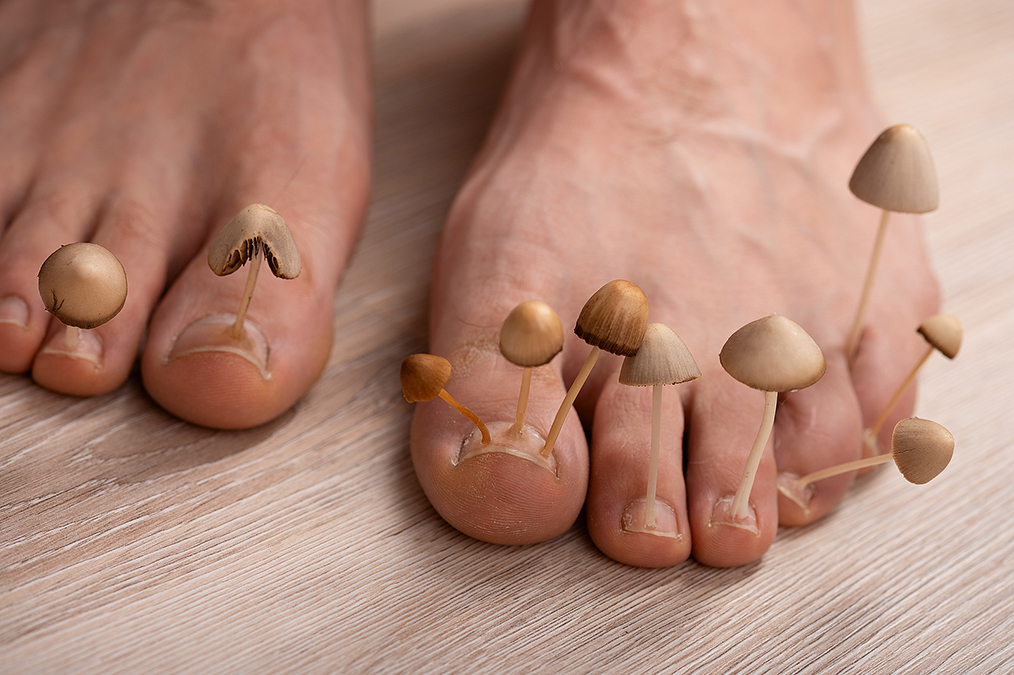 Where did your nail fungus come from?
Where did your nail fungus come from?
And maybe more importantly, where is it going?
According to a new study in the journal Fungal Infections in Dermatology, you’re very likely to spread it to those you love if you’re not careful.
That’s why today we’re going to explain how nail fungus spreads and how we can stop it.
Nail fungus, or onychomycosis, is caused by fungi. As fungi are generally able to live and spread on surfaces, scientists from the University of British Columbia in Vancouver wondered whether onychomycosis was able to spread via surfaces within the household.
They searched through medical databases to find relevant studies on the transmission of this fungal infection among people who live together and found 90 relevant studies published between 1954 and 2020.
Their main finding was that in a household with one affected member, the risk of transmission to other household members was between 44 and 47%.
It is clear that the infections were being transmitted within the household, rather than independently acquired elsewhere, as the nails of the different household members tended to be infected by exactly the same organism.
So how exactly do these organisms spread inside households?
-
1. They flourish on wet surfaces where people walk barefoot, like showers, bathtubs, gym mats, pathways to swimming pools, changing rooms, and, incredibly, beach sand and garden soil.
2. They can live in carpets.
3. One study found them living on 24% of the hair equipment tested, including brushes and combs, from where they can spread to other people’s fingernails.
4. They survive on towels, bedding, and articles of clothing, even after these have been machine washed.
5. These organisms can even live on soap, which families often share.
6. They are common inside slippers, sandals, socks, and other footwear, where they can also survive washing.
7. Some of these fungi have been found to survive in nail polish for 60 days. If this item is shared, the fungi can easily spread.
8. Even though they did not find any studies to prove it, the researchers speculated that nail clippers, files, and scissors could likely also spread these fungi.
9. They live on cleaning supplies like mops, scrubbers, and wipes that are repeatedly used throughout the home, ironically to clean surfaces.
10. One study found them on 48.4% of the vacuum cleaners tested.
11. Our furry family members can also carry fungi, including those that cause nail fungus, which they can spread to us. These carriers include unusual pets like guinea pigs and rabbits.
12. The most vulnerable people are those with diabetes, psoriasis, poor peripheral blood circulation, and weak immune systems.
So, how can these organisms be killed?
According to the research, they die at temperatures above 140°F (60°C), so it’s a good idea to wash your laundry at this temperature.
Bleach and other disinfectants can also kill these organisms. The authors of the study recommend regularly disinfecting household cleaning tools to prevent the spread of fungi.

 Overcoming IBD
Overcoming IBD Multiple Sclerosis
Multiple Sclerosis Banishing Bronchitis
Banishing Bronchitis Gum Disease Gone
Gum Disease Gone Overcoming Onychomycosis
Overcoming Onychomycosis Neuropathy No More
Neuropathy No More The Prostate Protocol
The Prostate Protocol Brain Booster
Brain Booster
 Ironbound
Ironbound
 Solution for Shingles
Solution for Shingles
 The Bone Density Solution
The Bone Density Solution
 The Ultimate Healing Protocol
The Ultimate Healing Protocol
 The Parkinson's Protocol
The Parkinson's Protocol
 The Chronic Kidney Disease Solution
The Chronic Kidney Disease Solution
 Overthrowing Anxiety
Overthrowing Anxiety The Fatty Liver Solution
The Fatty Liver Solution The Hypothyroidism Solution
The Hypothyroidism Solution
 The End of Gout
The End of Gout The Blood Pressure Program
The Blood Pressure Program
 The Oxigized Cholesterol Strategy
The Oxigized Cholesterol Strategy
 Stop Snoring And Sleep Apnea Program
Stop Snoring And Sleep Apnea Program
 The Arthritis Strategy
The Arthritis Strategy The Vertigo & Dizziness Program
The Vertigo & Dizziness Program The 3-Step Diabetes Strategy
The 3-Step Diabetes Strategy Hemorrhoids Healing Protocol
Hemorrhoids Healing Protocol The Erectile Dysfunction Master
The Erectile Dysfunction Master Weight Loss Breeze
Weight Loss Breeze The IBS Program
The IBS Program The Insomnia Program
The Insomnia Program The Migraine and Headache Program
The Migraine and Headache Program The Neck Pain Solution
The Neck Pain Solution The Menopause Solution
The Menopause Solution The Ejaculation Master
The Ejaculation Master The TMJ Solution
The TMJ Solution The Acid Reflux Solution
The Acid Reflux Solution The Fibromyalgia Solution
The Fibromyalgia Solution The Psoriasis Strategy
The Psoriasis Strategy